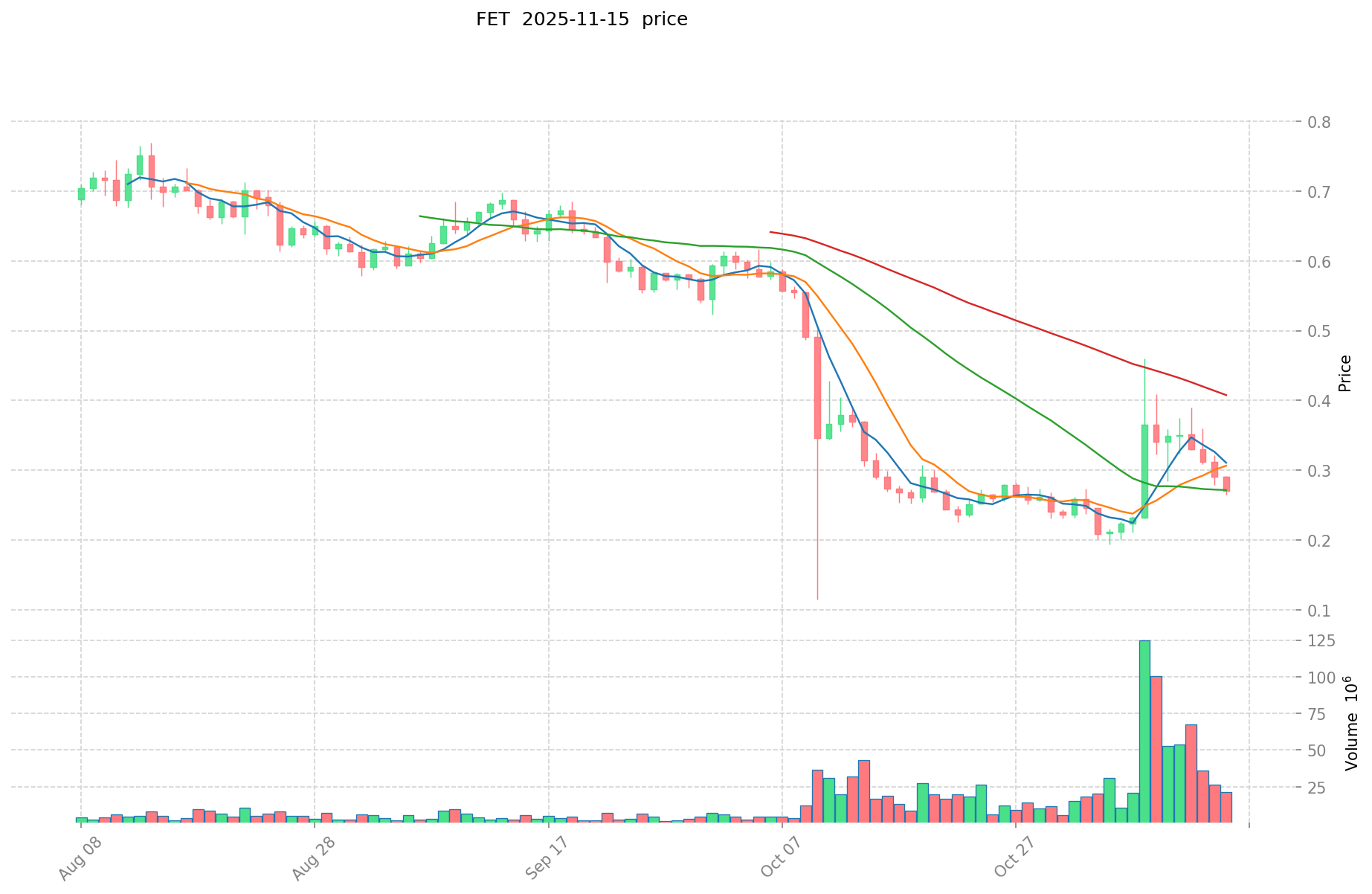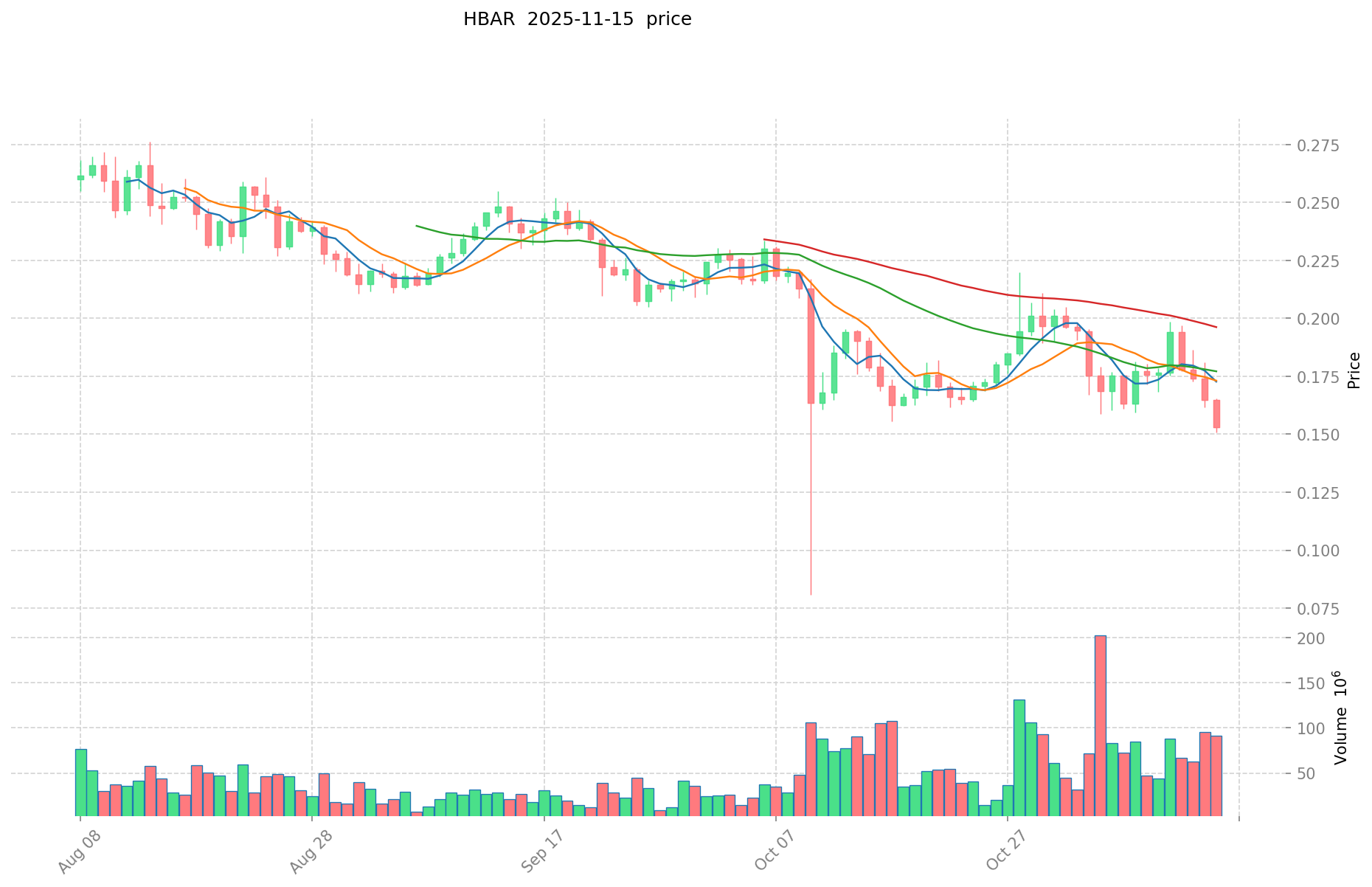FET vs HBAR: Comparing Two Innovative Distributed Ledger Technologies
Introduction: FET vs HBAR Investment Comparison
In the cryptocurrency market, the comparison between FET vs HBAR has always been a topic that investors cannot avoid. The two not only show significant differences in market cap ranking, application scenarios, and price performance, but also represent different positioning in crypto assets.
Artificial Superintelligence Alliance (FET): Since its launch in 2019, it has gained market recognition for its focus on building an economic internet using AI and machine learning.
Hedera (HBAR): Introduced in 2019, it has been hailed as a fast and secure public ledger network, becoming one of the cryptocurrencies with significant global trading volume and market capitalization.
This article will comprehensively analyze the investment value comparison between FET vs HBAR, focusing on historical price trends, supply mechanisms, institutional adoption, technological ecosystems, and future predictions, attempting to answer the question most concerning to investors:
"Which is the better buy right now?"
I. Price History Comparison and Current Market Status
FET (Coin A) and HBAR (Coin B) Historical Price Trends
- 2021: HBAR reached its all-time high of $0.569229 on September 15, 2021, due to increased adoption and market optimism.
- 2020: FET hit its all-time low of $0.00827034467596 on March 13, 2020, during the global market crash caused by the COVID-19 pandemic.
- Comparative analysis: In the recent market cycle, FET has dropped from its all-time high of $3.474265080421965 to its current price of $0.2722, while HBAR has fallen from its peak of $0.569229 to $0.15377.
Current Market Situation (2025-11-15)
- FET current price: $0.2722
- HBAR current price: $0.15377
- 24-hour trading volume: FET $5,874,845.668669 vs HBAR $14,460,290.8434815
- Market Sentiment Index (Fear & Greed Index): 16 (Extreme Fear)
Click to view real-time prices:
- View FET current price Market Price
- View HBAR current price Market Price


II. Core Factors Affecting the Investment Value of FET vs HBAR
Supply Mechanism Comparison (Tokenomics)
- FET: Fixed total supply of 1,152,997,575 FET tokens with a deflationary model where tokens are burned during network transactions
- HBAR: Total supply of 50 billion HBAR with a gradual release schedule over multiple years; employs a proof-of-stake consensus mechanism
- 📌 Historical pattern: Deflationary models like FET's tend to create upward price pressure over time, while HBAR's controlled release helps manage volatility but may limit short-term price appreciation.
Institutional Adoption and Market Applications
- Institutional holdings: HBAR has stronger institutional backing with major corporations like Google, IBM, and Boeing on its Governing Council
- Enterprise adoption: HBAR has more established enterprise use cases in areas like payment systems and document verification, while FET focuses on AI integration and machine learning applications
- Regulatory attitudes: Both projects have worked toward regulatory compliance, though Hedera's corporate governance structure gives it an advantage in regulated markets
Technical Development and Ecosystem Building
- FET technical upgrades: Advanced AI capabilities, machine learning integration, and development of the Fetch.ai collective learning system
- HBAR technical development: High throughput (10,000+ TPS), low fees, and enhanced security through its hashgraph consensus algorithm
- Ecosystem comparison: HBAR has more developed real-world applications in supply chain, credentialing, and identity management, while FET is building momentum in decentralized AI markets and autonomous agent technology
Macroeconomic and Market Cycles
- Performance in inflationary environments: Both have shown moderate correlation with broader crypto markets during inflation periods
- Macroeconomic monetary policy: Interest rate increases have historically affected both assets, though their technology-driven value propositions provide some insulation
- Geopolitical factors: FET's focus on AI could benefit from increasing global interest in AI solutions, while HBAR's enterprise connections may provide stability during market uncertainty
III. 2025-2030 Price Prediction: FET vs HBAR
Short-term Prediction (2025)
- FET: Conservative $0.228167 - $0.2749 | Optimistic $0.2749 - $0.362868
- HBAR: Conservative $0.1294944 - $0.15416 | Optimistic $0.15416 - $0.2111992
Mid-term Prediction (2027)
- FET may enter a growth phase, with estimated prices ranging from $0.190852074 to $0.388400712
- HBAR may enter a steady growth phase, with estimated prices ranging from $0.14202425502 to $0.22957345332
- Key drivers: Institutional capital inflow, ETF, ecosystem development
Long-term Prediction (2030)
- FET: Base scenario $0.4964785673652 - $0.650386923248412 | Optimistic scenario $0.650386923248412+
- HBAR: Base scenario $0.235899563835384 - $0.26420751149563 | Optimistic scenario $0.26420751149563+
Disclaimer: This analysis is based on historical data and projections. Cryptocurrency markets are highly volatile and unpredictable. This information should not be considered as financial advice. Always conduct your own research before making investment decisions.
FET:
| 年份 | 预测最高价 | 预测平均价格 | 预测最低价 | 涨跌幅 |
|---|---|---|---|---|
| 2025 | 0.362868 | 0.2749 | 0.228167 | 0 |
| 2026 | 0.3507724 | 0.318884 | 0.27424024 | 17 |
| 2027 | 0.388400712 | 0.3348282 | 0.190852074 | 23 |
| 2028 | 0.45563421456 | 0.361614456 | 0.26397855288 | 32 |
| 2029 | 0.5843327994504 | 0.40862433528 | 0.3187269815184 | 50 |
| 2030 | 0.650386923248412 | 0.4964785673652 | 0.302851926092772 | 82 |
HBAR:
| 年份 | 预测最高价 | 预测平均价格 | 预测最低价 | 涨跌幅 |
|---|---|---|---|---|
| 2025 | 0.2111992 | 0.15416 | 0.1294944 | 0 |
| 2026 | 0.206427948 | 0.1826796 | 0.122395332 | 19 |
| 2027 | 0.22957345332 | 0.194553774 | 0.14202425502 | 27 |
| 2028 | 0.2459937918456 | 0.21206361366 | 0.1399619850156 | 38 |
| 2029 | 0.242770424917968 | 0.2290287027528 | 0.13741722165168 | 49 |
| 2030 | 0.26420751149563 | 0.235899563835384 | 0.188719651068307 | 54 |
IV. Investment Strategy Comparison: FET vs HBAR
Long-term vs Short-term Investment Strategy
- FET: Suitable for investors focused on AI and machine learning potential
- HBAR: Suitable for investors seeking enterprise adoption and stability
Risk Management and Asset Allocation
- Conservative investors: FET: 30% vs HBAR: 70%
- Aggressive investors: FET: 60% vs HBAR: 40%
- Hedging tools: Stablecoin allocation, options, cross-currency portfolio
V. Potential Risk Comparison
Market Risk
- FET: Higher volatility due to smaller market cap and AI-focused niche
- HBAR: Susceptible to enterprise adoption rates and competition from other enterprise-focused blockchains
Technical Risk
- FET: Scalability, network stability
- HBAR: Centralization concerns, potential security vulnerabilities
Regulatory Risk
- Global regulatory policies may impact both differently, with HBAR potentially having an advantage due to its corporate governance structure
VI. Conclusion: Which Is the Better Buy?
📌 Investment Value Summary:
- FET advantages: Strong focus on AI and machine learning, deflationary model
- HBAR advantages: Established enterprise adoption, high throughput, low fees
✅ Investment Advice:
- New investors: Consider a balanced approach with a slight tilt towards HBAR for its established use cases
- Experienced investors: Explore a higher allocation to FET for potential AI-driven growth
- Institutional investors: HBAR may be more attractive due to its enterprise connections and regulatory compliance
⚠️ Risk Warning: The cryptocurrency market is highly volatile, and this article does not constitute investment advice. None
FAQ
Q1: What are the main differences between FET and HBAR? A: FET focuses on AI and machine learning applications, has a fixed supply with a deflationary model, and is more volatile. HBAR has strong enterprise adoption, uses a proof-of-stake consensus mechanism, and offers high throughput with low fees.
Q2: Which cryptocurrency has shown better price performance historically? A: Based on the available data, HBAR reached a higher all-time high of $0.569229 in September 2021, compared to FET's all-time high of $3.474265080421965. However, both have experienced significant drops from their peaks.
Q3: How do the supply mechanisms of FET and HBAR differ? A: FET has a fixed total supply of 1,152,997,575 tokens with a deflationary model where tokens are burned during transactions. HBAR has a total supply of 50 billion tokens with a gradual release schedule over multiple years.
Q4: Which cryptocurrency has stronger institutional backing? A: HBAR has stronger institutional backing with major corporations like Google, IBM, and Boeing on its Governing Council. FET's institutional adoption is less prominent in comparison.
Q5: What are the key factors that could drive the future price of FET and HBAR? A: For FET, advancements in AI and machine learning integration could be key drivers. For HBAR, increased enterprise adoption and expansion of real-world applications in supply chain, credentialing, and identity management could drive growth.
Q6: How do FET and HBAR compare in terms of risk? A: FET generally carries higher risk due to its smaller market cap and focus on the AI niche, which may lead to higher volatility. HBAR, while still subject to market risks, may offer more stability due to its enterprise connections and established use cases.
Q7: Which cryptocurrency might be better for long-term vs. short-term investment? A: For long-term investment, FET might appeal to those betting on the future of AI and machine learning in blockchain. HBAR may be more suitable for investors seeking stability through enterprise adoption. Short-term investors should consider market trends and risk tolerance when choosing between the two.
Share
Content